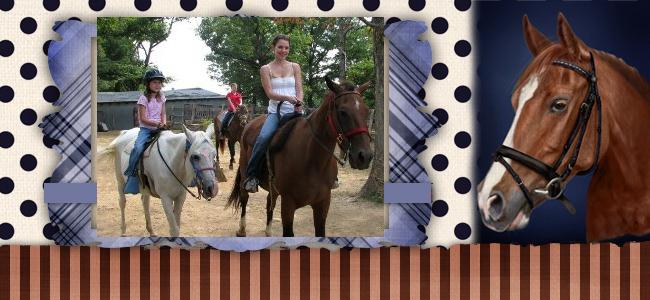 If you're going to work with horses, you'll need to know how to saddle and bridle one. We call this "tacking" the horse up. The saddle and bridle are referred to as the tack, and the act of saddling the horse is called tacking it up.
If you're going to work with horses, you'll need to know how to saddle and bridle one. We call this "tacking" the horse up. The saddle and bridle are referred to as the tack, and the act of saddling the horse is called tacking it up.Whether you're tacking a horse Western or English style, you'll need someone with you who knows what they're doing.
You'll want to tie the horse, but do it loosely so that the horse can look around and move its feet. If the horse can't move its feet, it will feel trapped and may kick or try to bolt. But tie the lead tight enough so that, if the horse is touchy about the girth, it can't reach it's head around to nip at you if you get the girth too tight.
To start, you may want to give the horse a light brushing around the back, withers, and girth area, where the saddle will be. Make sure there are no clumps of dirt in that area that might aggravate the horse when the saddle is put on it.
You'll need to put a saddle pad on the horse's back first, just to ensure that the saddle doesn't rub on the horse's back and make it sore. Place the saddle pad high on the withers and make sure it's even. Then place the saddle just slightly on the withers. Draw the girth down and tighten it snug - loose enough to be comfortable for the horse but tight enough so that it doesn't wriggle around on the horse's back. But it's okay if you can't get it tight enough. You'll be warming the horse up before you ride, so that should loosen him up and allow you to tighten the girth before you ride him.
To put the bridle on, go to the left side of the horse's head and put your right arm under the horse's jaw and throat and rest it on his nose. With your left hand, hold the top of the bridle (the head piece) and get the bit up to the horse's mouth. Use your right hand to guide the bit into the horse's mouth. If the horse refuses the bit, DO NOT bang it against the horse's teeth. This will only aggravate the horse and he may fling his head up.
Stick your fingers into the corner of the horse's mouth where there are no teeth, and the horse will open his mouth and you can easily slip the bit in. Put the head piece over the horse's ears and strap the throat latch in.
If the horse holds his head too high for you to reach, you can offer him a treat (probably a carrot or apple), which will get him to lower his head to take it. When you're bridling the horse, an important thing is to have the horse tied so that it can't raise its head too high. If it does, pull the lead pretty hard until the horse lowers his head.
Warm the horse up before you start riding. Lunge him and get him to move around. Back him up, lead him, get him to move different parts of his body around (his front end and his hind end).
Before you mount, check the saddle girth. If you couldn't get it very tight before, that's okay. It's good to wait to tighten it until after the horse is warmed up and loosened. He should allow you to tighten the girth without any problems.
Check the bridle, too, to make sure the horse didn't try to rub his head on anything to loosen or damage the bridle.
And, now, you have a saddled and bridled horse! Have a nice ride!

4 comments:
cheap jordans
jordan shoes
jordan shoes
kyrie 5 spongebob
yeezy boost 350
pg 1
yeezy boost 350 v2
yeezys
curry shoes
longchamp handbags
w6h43y2w18 y5w00l0f44 i3g82n4x46 z3h90n1x12 w2i19y3n61 m7h07m8e38
jordan shoes
palm angels hoodie
yeezy 500
kyrie shoes
supreme outlet
golden goose sneakers
golden goose superstar
golden goose
off-white
off white shoes
jordan 11
bapesta
cheap jordan
yeezy 700
supreme outlet
jordans
supreme clothing
kd 15
off white hoodie
goyard
Post a Comment